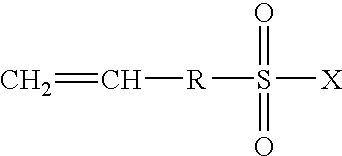Highly proton-conductive polymer electrolyte membranes that excel in mechanical strength and a process for producing the same
a technology of high-proton conductivity and electrolyte, applied in the field of high-proton-conductive polymer electrolyte membranes, can solve the problems of difficult to achieve high-levels of both proton conductivity and membrane strength, low graft polymerizability of functional monomers to aromatic hydrocarbon-based polymer film substrates, and high degree of grafting. , the effect of high degree of grafting
- Summary
- Abstract
- Description
- Claims
- Application Information
AI Technical Summary
Benefits of technology
Problems solved by technology
Method used
Image
Examples
example 1
[0066]A film of polyetheretherketone (PEEK) (the aromatic hydrocarbon-based polymer product of Victrex; Victrex APTIV™ Film 2000 Series) was used as a substrate. This substrate was 50 μm thick, 100 mm wide, and 200 mm long.
[0067]To perform the first graft polymerization step, divinylbenzene (DVB) (80% isomer mixture manufactured by Wako Pure Chemical Industries, Ltd.) was mixed with 1,4-dioxane at a ratio of 25:75 (in vol %) and the resulting mixed solution was used as the reaction solution. The above-mentioned substrate PEEK film was immersed in this reaction solution, which was purged of the air by flowing the inert gas argon at ordinary temperatures for 20 minutes. Then, thermal graft polymerization was performed at 50° C. for 20 hours. The substrate with the resulting graft chains was dried by heating at 80° C. for 80 hours.
[0068]To determine the degree of grafting in the first graft polymerization step (which is hereinafter sometimes referred to as “degree of grafting 1”), the ...
example 2
[0084]The procedure of Example 1 was repeated, except that in the second graft polymerization step, divinylbenzene (80% isomer mixture manufactured by Wako Pure Chemical Industries, Ltd.) was added as a crosslinking agent to the graft reaction solution. Thus, the graft reaction solution used in the second graft polymerizations step consisted of ethyl styrenesulfonate, divinylbenzene and dioxane at a ratio of 24:1:75 (in vol %). The characteristics of the thus obtained polymer electrolyte membrane were measured and evaluated as in Example 1. The results are shown in Table 1.
example 3
[0085]The procedure of Example 1 was repeated, except that in the first graft polymerization step, styrene was substituted for DVB as the vinyl monomer. Thus, the graft reaction solution to be used in the first graft polymerization step consisted of styrene and dioxane at a ratio of 25:75 (vol %). The characteristics of the thus obtained polymer electrolyte membrane were measured and evaluated as in Example 1. The results are shown in Table 1.
PUM
| Property | Measurement | Unit |
|---|---|---|
| ion-exchange capacity | aaaaa | aaaaa |
| temperature | aaaaa | aaaaa |
| temperature | aaaaa | aaaaa |
Abstract
Description
Claims
Application Information
 Login to View More
Login to View More - R&D
- Intellectual Property
- Life Sciences
- Materials
- Tech Scout
- Unparalleled Data Quality
- Higher Quality Content
- 60% Fewer Hallucinations
Browse by: Latest US Patents, China's latest patents, Technical Efficacy Thesaurus, Application Domain, Technology Topic, Popular Technical Reports.
© 2025 PatSnap. All rights reserved.Legal|Privacy policy|Modern Slavery Act Transparency Statement|Sitemap|About US| Contact US: help@patsnap.com



